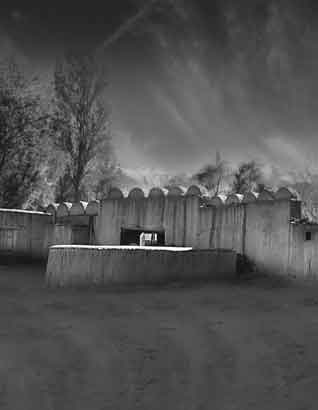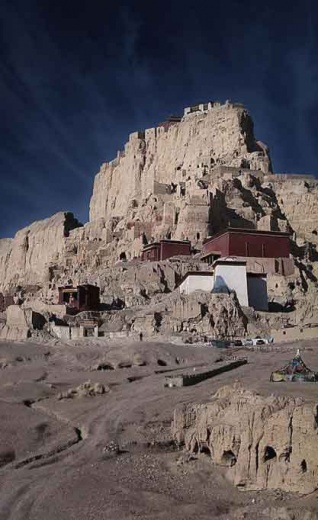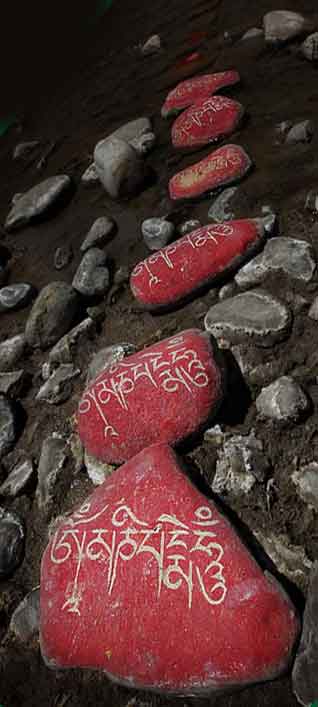Travel
The Ladakh-Tibet Expedition of Ranjit Singh's Army
Text & Photos by AMARDEEP SINGH
Hundreds of human skeletons, some with frozen flesh still clinging to them, can be found around Roopkund (16,500 feet), a remote glacial lake in the lap of Trishul massif in the Himalayas. The presence of these skeletons was first discovered in 1942 by the Himalayan ranger H K Madhwal.
I was fortunate to be schooled at The Doon School, Dehradun (India), an institution that valued the importance of growth by encouraging its pupils to trek in the Himalayas.
In 1983, when I was 17, a group of senior students successfully trekked to Roopkund, bringing back samples of human bones.
With obvious curiosity, I asked my housemaster, Mr. Vaishnav, “Why are so many skeletons found around this remote lake?”
He replied, “These are believed to be the remains of General Zorawar Singh’s soldiers who got lost in the Himalayas while returning from the Tibetan plateau.”
Who was General Zorawar Singh?
The plains of the sub-continent have been repeatedly invaded since the 9th century, looted and ruled by many dynasties. It was only with the rise of the Sikh kingdom in Punjab, and during the rule of Maharajah Ranjit Singh (1780 – 1839), the “Lion of Punjab”, that this trend was brought to a halt.
Ranjit Singh’s military career can be divided into three phases.
1799 – 1809: Consolidation of the Sikh forces, leading to the capture of Lahore and the establishment of the Sikh Kingdom.
1809 – 1823: Expansion of the Sikh Empire to include Multan, Peshawar and Kashmir, and the defeat of the Afghans. It is in this phase that Hari Singh Nalwa, his trusted General, extended the empire’s reach to Khyber pass, along the Afghanistan border. This was a historic achievement as only thereafter no foreign invasion to the sub-continent would happen from Afghanistan.
1823 – 1839 : Consolidation and further expansion. It is in this phase that General Zorawar Singh, operating under the military leadership of Gulab Singh (the Dogra minister in Ranjit Singh’s cabinet who was assigned the management of the affairs of Kashmir), led expansionary military expeditions to Ladakh (1834), Baltistan (1840) and Tibet (1841).
The British had conquered the rest of the subcontinent, having been stopped in their tracks at the River Sutlej by the Sikhs and were now limited by the Treaty of Amritsar with Maharajah Ranjit Singh, prohibiting the British from making a westward advance into Punjab and beyond. Ranjit Singh, in return, promised to stay clear of the territories east of river Sutlej. The only option for expansion of the Sikh kingdom was, inter alia, North of Kashmir into Ladakh.
Zorawar Singh was born at Khalur, Punjab -- now in the newly created state of Himachal Pradesh. At a very young age, he rose to become a General in Maharajah Ranjit Singh’s army.
In 1834, General Zorawar Singh led an expedition to Ladakh via Kishtwar, Dachin, Marwah, Warwan, crossing the Lanvila pass at 14,500 feet. At Suru and Leh valley, his forces constructed forts for administration of the region.
In 1840, Zorawar Singh led an expedition to Baltistan, which is believed to be one of the most rugged mountain regions in the world. It is situated in the Karakoram range to the south of K2, the world’s second highest mountain. Since 1757, Baltistan was under the rule of Ahmed Shah Durrani of Afghanistan. If not for this expedition, Baltistan would today be part of Afghanistan.
Baltistan is the region where the Dards live along with Balti people. Dards are of European origin, believed to be descendants of the soldiers of Alexander The Great (327 BC).
Having conquered Baltistan, General Zorawar Singh returned to Leh via the Khapalu – Chorbat – Nubra valley route. Nubra valley is a high altitude cold desert at 10,000 feet. It is on the historical silk route.
In 1841, General Zorawar Singh turned his attention to the ‘roof of the world‘, which led him to Western Tibet. Crossing Pangong Tso lake at 14,300 feet, at the Ladakh – Western Tibet border, he travelled via Guge kingdom, Tholing, Purang to Mount Kailash and Mansarovar.
At Purang Valley, which lies separated from Mansarovar by the Gurla Mandhata range, his forces climbed the Gurla pass and reached Dogpacha. Here they were caught totally off-guard by the Tibetan forces. A fierce hand to hand battle resulted in a victory by the Sikh forces, who captured the Tibetan army “colors” which today lie in the possession of the Indian Army.
After the visit to Mount Kailash and Mansarovar, General Zorawar Singh’s army turned South towards Taklakot, where a battle was fought with the Tibetan forces at the high altitude Mayum pass (17,000 feet).
In an operation lasting three and a half months, some 550 miles of Tibetan territory was captured by General Zorawar Singh and his Sikh troops.
In July 1841, G T Lushington, the British Commissioner of Kumaon in India, learnt that extensive territories in Tibet have been captured. British were alarmed and decided to send Captain J D Cunningham to the Sikh Darbar in Lahore to discuss the matter as this was seen as a threat to British India. Ranjit Singh’s remained evasive of Cunnigham’s queries, thus letting General Zorawar Singh have more time to complete his task.
By now the winters were fast approaching. General Zorawar Singh decided to move to Tirthapuri and prepare for the offense in the coming summer months.
While the General had everything going his way as he had sealed the Mayum pass before the arrival of winter, he had however made a small miscalculation. He did not take into account that forces from Lhasa could also reach via the Matsang pass, which was South of Mayum pass and was negotiable even in the winter months. This was a strategic mistake.
In the peak winter months, as General Zorawar Singh’s forces became complacent, the Tibetan forces attacked through Matsang pass and caught them off-guard. High altitude battle in the peak winter months against a large Tibetan force was fought. During the night the weather turned against them with a heavy snow storm. Many soldiers were frost bitten and were dying due to insufficient clothing.
On 12th December, 1841 General Zorawar Singh was hit by a bullet on his left shoulder and died at Taklakot. Even though the morale of the forces was broken, it was only by January 1842 that the last fortifications, under the command of Basti Ram (military officer of General Zorawar Singh) abandoned their positions.
With him, many soldiers crossed the Tibetan plateau but only 242 of them reached Askot in Kumaon, which was in the British India territory. From here they continued the journey to Ludhiana and entered the Sikh Kingdom to the east of river Sutlej.
General Zorawar Singh’s severed head was carried to Lhasa where it was placed at a thoroughfare for public viewing.
The Tibetans however also recognized the valor of General Zorawar Singh and built a Chorten (Cenotaph) at Taklakot in his memory. Even today, the Tibetans call it “Singh ba Chorten” or the Cenotaph of the “Singh Warrior”.
About the soldiers who were taken into captivity, Tsepon W. D. Shakabpa, who served as Tibet’s Secretary of Finance from 1930 -1950, writes on page 243 – 244 of his book, TIBET – A Political History : “Over three thousand Sikhs were killed in the course of the foray. Seven hundred Sikhs and two Ladakhi ministers were taken prisoners. The remainder of the defeated army fled … Those prisoners wishing to return to their country were allowed to do so … One third of the Sikhs and Ladakhi prisoners elected to remain in Tibet. The Sikhs were resettled in warmer regions of Southern Tibet by the government and many married Tibetan girls. The Sikhs are known to have introduced the cultivation of apricots, apples, grapes and peaches into the country.”
So what about the skeletons at Roopkund lake? Are these of the retreating soldiers accompanying Basti Ram, who may have lost their way and perished at the high altitude?
A recent expedition to Roopkund lake by a National Geographic team retrieved about 30 skeletons and their carbon dating has placed the time of mass death to 9th century AD.
While the mystery of Roopkund, through scientific investigation has negated it’s linkage to the Tibet expedition of General Zorawar Singh, but a curious conversation with Mr. Vaishnav at The Doon School in the year 1983 has sub-consciously led me to these remote places, tracing the footsteps of the Sikh expedition.
Edited for sikhchic.com.
Please CLICK here to view the complete photo exhibit.
September 27, 2013
Conversation about this article
1: SSN (USA), September 27, 2013, 10:06 AM.
My heart swells with pride. I also note the respect the great Buddhist tribes of Tibet accorded to fallen Sikhs as against what happened to our heroes in areas falling in present-day Pakistan/Afghanistan while making their sacrifices for India. Amardeep Singh - it seems like you have primarily done this due to a personal interest. What is your next step? How can the broader Sikh community help?
2: Amardeep Singh (Singapore), September 27, 2013, 8:28 PM.
Dear SSN: Indeed all of my projects, some of which have been featured in the past under the Arts and Travel sections of sikhchic.com, have been undertaken on a personal basis. At this stage I am considering publication of some of my work and actively looking for book sponsorships. I am hoping there are some in the community who can partner on this front. My weekly blog can be seen at www.amardeepphotography.com. I can be contacted for discussion at amardeepsinghranghar@yahoo.com.sg
3: Sangat Singh (Kuala Lumpur, Malaysia ), September 27, 2013, 9:59 PM.
Thanks, Amardeep ji, for providing a visual, indelible part of our proud history. Keep going, Amardeep ji.






